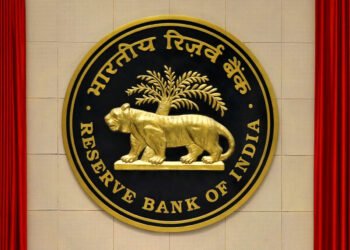Foreign investors withdraw ₹12,569 crore from Indian equities in just seven days amid global volatility and AI-led investment shifts, raising short-term market concerns but leaving long-term fundamentals intact.
Mumbai (Economy India): Foreign portfolio investors (FPIs) have once again turned net sellers in Indian equities, pulling out ₹12,569 crore within just the first seven days of November. After a brief return to buying in October, FPIs are now offloading their holdings amid concerns that India is lagging behind other markets in the ongoing global Artificial Intelligence (AI) investment rally.
According to exchange data, the sharp reversal in FPI sentiment has raised concerns over near-term volatility in the Indian stock market, which had recently witnessed record highs on the back of strong domestic inflows.
FPIs Resume Selling Amid Global Risk-Off Sentiment
Analysts attribute the renewed outflows to global risk aversion, AI-driven capital reallocation, and valuation pressures in the Indian market.
V.K. Vijayakumar, Chief Investment Strategist at Geojit Financial Services, explained that hedge funds and FPIs are redirecting their portfolios toward developed markets such as the U.S., China, South Korea, and Taiwan, which are benefiting from the AI boom.
“FPIs are chasing returns in markets that are at the center of the AI revolution. India, despite its long-term potential, is currently seen as an AI underperformer. This sentiment is leading to short-term withdrawals,” Vijayakumar said.
He further added that the high valuation of Indian equities compared to emerging market peers has limited the scope for aggressive foreign buying. However, he emphasized that once earnings momentum strengthens and valuations stabilize, FPIs could gradually return.

October’s Rebound Fizzles Out in November
October had briefly offered hope of a turnaround in FPI behavior, with inflows of ₹14,610 crore after three consecutive months of selling.
But that recovery appears short-lived, as FPIs withdrew ₹12,569 crore in the first week of November alone.
Here’s a look at FPI activity over the past few months:
| Month | Net FPI Flow (₹ crore) | Trend |
|---|---|---|
| July 2025 | -17,700 | Outflow |
| August 2025 | -34,990 | Outflow |
| September 2025 | -23,885 | Outflow |
| October 2025 | +14,610 | Inflow |
| November 2025 (so far) | -12,569 | Outflow |
So far in calendar year 2025, foreign portfolio investors have withdrawn over ₹1.5 lakh crore from Indian equities, making it one of the largest annual outflows in recent years.
AI Valuations, Fed Policy and Global Uncertainty Weigh on Sentiment
Experts say the outflow trend is also influenced by uncertainty in global monetary policy, especially regarding the U.S. Federal Reserve’s stance on interest rates.
A stronger dollar and sustained U.S. yields have kept investors cautious about emerging market assets like India.
According to analysts, AI-driven investments in semiconductor, robotics, and software automation sectors have pulled liquidity toward U.S. and East Asian markets, leaving relatively less room for India, which lacks listed AI-heavy companies at scale.
“While global investors are chasing the AI boom elsewhere, India’s opportunity lies in steady domestic growth, digital infrastructure, and manufacturing expansion,” Vijayakumar noted.
Corporate Earnings Could Support Market Resilience
Despite the FPI withdrawals, India’s corporate earnings season for the second quarter of FY2025-26 has provided some optimism.
Analysts at Angel One said that better-than-expected Q2 results, particularly from midcap and financial sector companies, could attract selective foreign inflows once global volatility subsides.
“The near-term outlook remains cautious, but strong earnings and healthy macro fundamentals will act as a cushion for the market,” said Waqaar, Senior Fundamental Analyst at Angel One.
He added that midcap and infrastructure-linked stocks may continue to outperform, even as foreign investors remain on the sidelines temporarily.
Markets End the Week Lower on FPI Selling Pressure
On Friday, November 7, the Sensex slipped 95 points to close at 83,216, while the Nifty fell 17 points to settle at 25,492, erasing early gains after sharp intraday volatility. The market was down nearly 600 points intraday before recovering partially toward the close.
Out of the 30 Sensex stocks, 16 ended in the red, led by:
- Bharti Airtel (-4.4%)
- Tech Mahindra (-2.1%)
- Trent (-1.7%)
- Reliance Industries (-1.3%)
However, gains in Bajaj Finance, Tata Steel, and Bajaj Finserv — all up over 2% — helped limit the overall decline.
Short-Term Weakness, Long-Term Opportunity
While foreign outflows have triggered near-term market volatility, domestic institutional investors (DIIs) continue to lend strong support, cushioning the downside.
Experts believe that India’s robust economic growth, rising consumer demand, and policy stability will continue to attract long-term global capital.
“The short-term sell-off reflects global positioning, not India’s fundamentals. Once global liquidity stabilizes, India will remain a preferred emerging market destination,” said Vijayakumar.
In the medium term, FPI flows are expected to depend on three key factors:
- U.S. Federal Reserve’s interest rate path
- Global risk sentiment and currency trends
- Sustained corporate earnings growth in India
Key Takeaways
- FPIs withdrew ₹12,569 crore in the first week of November 2025.
- Over ₹1.5 lakh crore has been pulled out from Indian equities this year.
- AI investment boom in the U.S. and Asia diverts capital away from India.
- Strong Q2 earnings and domestic inflows may limit downside risk.
- Long-term outlook for Indian markets remains positive despite short-term volatility.
The recent withdrawal of ₹12,569 crore by Foreign Portfolio Investors (FPIs) in just one week highlights the sensitivity of India’s equity markets to global capital flows and shifting investor sentiment. While the short-term outlook appears cautious due to global uncertainties, AI-driven investment reallocations, and elevated valuations, India’s strong macroeconomic fundamentals, robust corporate earnings, and domestic consumption resilience continue to offer a solid long-term investment case
Experts believe that once the global risk-off phase stabilizes and the U.S. Federal Reserve provides clarity on its monetary stance, FPIs may gradually return to Indian equities. Until then, domestic institutional investors (DIIs) and retail participation are expected to provide critical market support.
In essence, while global trends are temporarily steering foreign capital away, India’s economic momentum and reform-driven growth story remain intact — positioning it as one of the most promising emerging markets in the world.
(Economy India)












